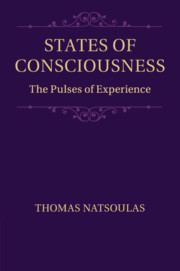Book contents
- States of Consciousness
- States of Consciousness
- Copyright page
- Dedication
- Contents
- Chapter 1 Introduction: Conscious Mental Phenomena
- Chapter 2 A Revisioning of the Stream of Consciousness
- Chapter 3 The Psychical Apparatus
- Chapter 4 Radical Behaviorism
- Chapter 5 Consciousness Denied
- Chapter 6 Psychophysiological Parallelism
- Chapter 7 On the Sensory-Perceptual Experiencing One Has of Things
- Chapter 8 A Theorist of “the Attention”
- Chapter 9 Conclusion: Against Disjunction
- References
- Index
- References
References
Published online by Cambridge University Press: 09 January 2018
- States of Consciousness
- States of Consciousness
- Copyright page
- Dedication
- Contents
- Chapter 1 Introduction: Conscious Mental Phenomena
- Chapter 2 A Revisioning of the Stream of Consciousness
- Chapter 3 The Psychical Apparatus
- Chapter 4 Radical Behaviorism
- Chapter 5 Consciousness Denied
- Chapter 6 Psychophysiological Parallelism
- Chapter 7 On the Sensory-Perceptual Experiencing One Has of Things
- Chapter 8 A Theorist of “the Attention”
- Chapter 9 Conclusion: Against Disjunction
- References
- Index
- References
- Type
- Chapter
- Information
- States of ConsciousnessThe Pulses of Experience, pp. 431 - 440Publisher: Cambridge University PressPrint publication year: 2018

